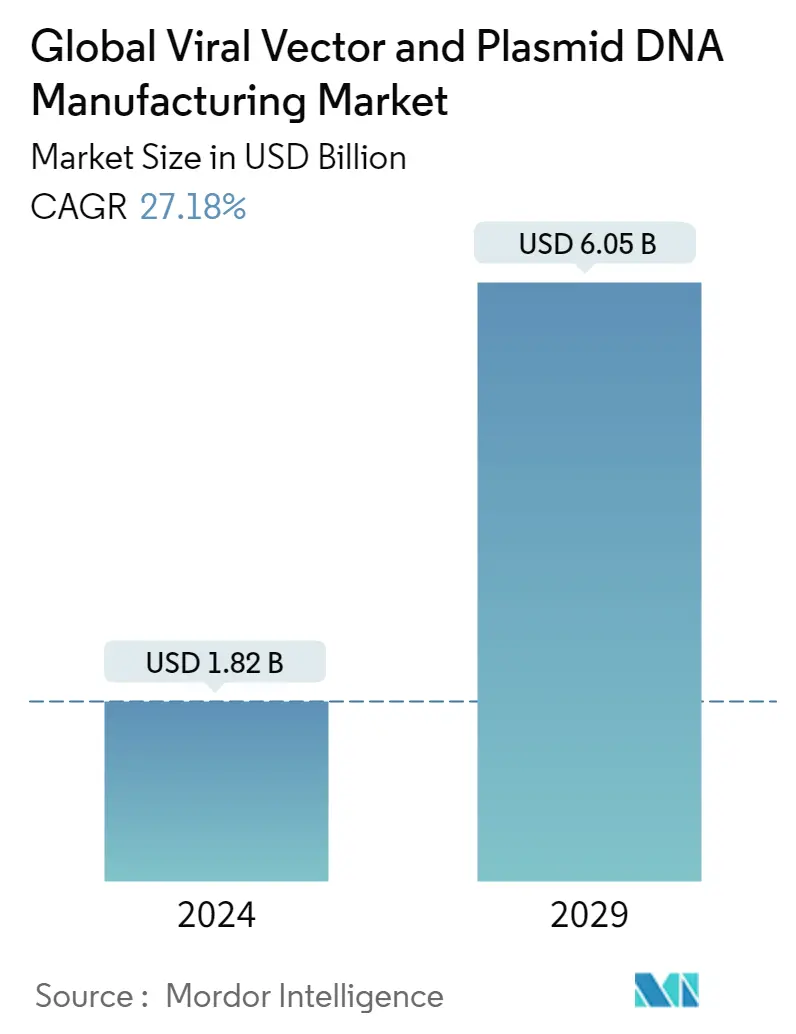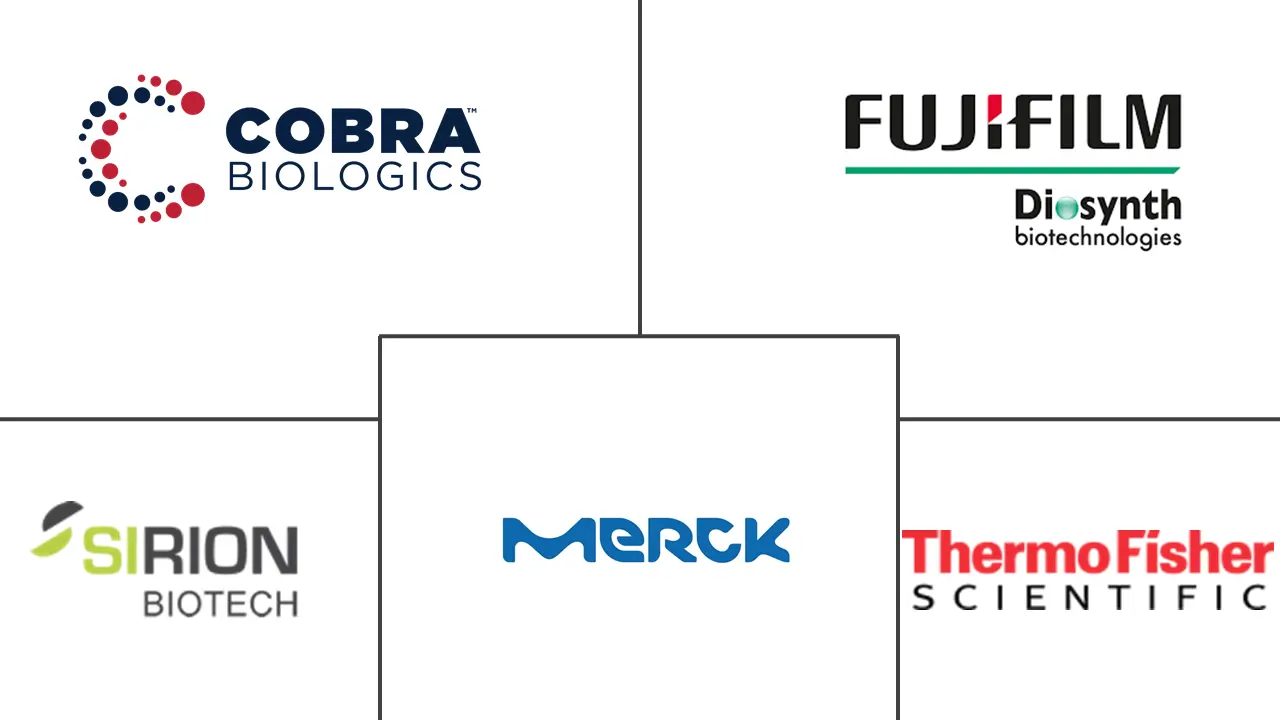Market Size of Global Viral Vector and Plasmid DNA Manufacturing Industry

| Study Period | 2019 - 2029 |
| Market Size (2024) | USD 1.82 Billion |
| Market Size (2029) | USD 6.05 Billion |
| CAGR (2024 - 2029) | 27.18 % |
| Fastest Growing Market | Asia Pacific |
| Largest Market | North America |
Major Players
*Disclaimer: Major Players sorted in no particular order |
Viral Vector & Plasmid DNA Manufacturing Market Analysis
The Global Viral Vector and Plasmid DNA Manufacturing Market size is estimated at USD 1.82 billion in 2024, and is expected to reach USD 6.05 billion by 2029, growing at a CAGR of 27.18% during the forecast period (2024-2029).
The COVID-19 outbreak is expected to positively impact the viral vector and plasmid DNA manufacturing market. Several COVID-19 vaccine candidates entering clinical trials also include viral vector vaccines. These vaccines are likely to be among the COVID-19 vaccines authorized for use worldwide. Many of them have also received or are in the final stages of receiving approval. In January 2021, Johnson & Johnson announced favorable efficacy and safety data from its Phase 3 ENSEMBLE clinical trial using its AdVac vaccine platform for COVID-19. Its single-dose COVID-19 vaccine, currently under development at its Janssen Pharmaceutical Companies, met all preconditions and targets. The AdVac viral vector technology could provide a potent and long-lasting humoral and cellular immune response to the body. Another viral vector-based vaccine, which has received several approvals, is the Oxford-AstraZeneca COVID-19 vaccine. The vaccine was first discovered in November 2020 and has since been mass-produced to vaccinate people. The COVID-19 viral vector vaccines are under development worldwide using non-replicating viral vectors. The immune response of these vaccines follows a similar pattern, i.e., it includes antibody-producing B cells and T cells, which seek out and destroy infected cells in the body, providing long-lasting immunity. Further research and increased investment in this field are expected to positively affect vaccine development.
Demand for plasmid DNA is growing steadily due to growth in gene therapy development. pDNA is a prerequisite for producing AAV (adeno-associated virus), lentivirus, and other viral vector platforms. There is also an increase in several genetic disorders and numerous life-threatening disorders, especially heart diseases, AIDS, cystic fibrosis, and age-related disorders. For instance, as per the Centers for Disease Control and Prevention, 2021, hypertension, or high blood pressure, is a leading risk factor for cardiovascular disease and causes an estimated 10 million deaths worldwide each year. These statistics represent 35% of global deaths. Gene therapy with viral vectors provides a complete cure to patients suffering from genetic disorders and other life-threatening disorders rather than ease symptoms with other treatments. Several clinical studies are being conducted on viral vectors and plasmid DNA manufacturing, emphasizing the potential of gene therapy to address important medical needs.
Several players, including pharmaceutical companies, contract manufacturing organizations, research institutes, and non-profit organizations, are playing a critical role in the development and production of these vectors. In April 2021, ViroCell Biologics, the UK clinical trial-focused viral vector manufacturer, launched its viral vectors. Through this launch, the company will supply viral vectors and gene-modified cells to academic and corporate clients for translational cell and gene therapies going into clinical trials.
Viral Vector & Plasmid DNA Manufacturing Industry Segmentation
As per the scope of the report, viral vectors and plasmid DNA are the products of gene therapy used for the treatment of several diseases, such as Alzheimer's disease, Parkinson's disease, and rheumatoid arthritis. Gene therapies and other therapies that require genetic modification include the introduction of therapeutic DNA/genes into a patient's body or cell by using vectors. Over the past few decades, various viral and non-viral vectors have been developed and standardized for this purpose. Viral vectors and plasmid DNA are known to reduce the cost of treatment and help in decreasing repeated administration of medications.
The market is segmented by product type (plasmid DNA, viral vector, and non-viral vector), application (cancer, genetic disorder, infectious disease, and other applications), and geography (North America, Europe, Asia-Pacific, Middle-East and Africa, and South America). The report offers the value in USD million for the above segments.
| By Product Type | |
| Plasmid DNA | |
| Viral Vector | |
| Non-viral Vector |
| By Application | |
| Cancer | |
| Genetic Disorder | |
| Infectious Disease | |
| Other Applications |
| Geography | ||||||||
| ||||||||
| ||||||||
| ||||||||
| ||||||||
|
Global Viral Vector and Plasmid DNA Manufacturing Market Size Summary
The viral vector and plasmid DNA manufacturing market is poised for significant growth, driven by advancements in gene therapy and the increasing demand for innovative medical treatments. This market is experiencing a surge in interest due to its critical role in the development of viral vector-based vaccines, such as those for COVID-19, and its application in gene therapy for various genetic and life-threatening disorders. The market is supported by a diverse range of stakeholders, including pharmaceutical companies, contract manufacturing organizations, and research institutes, all contributing to the development and production of these vital biopharmaceuticals. The ongoing research and clinical trials in this field underscore the potential of viral vectors and plasmid DNA in addressing significant medical challenges, particularly in cancer treatment and genetic disorder therapies.
North America is currently leading the market growth, with companies in the region innovating new product approaches and expanding production facilities to meet the rising demand for viral vector-based therapies. The region's focus on developing novel products and enhancing manufacturing capabilities is complemented by strategic initiatives such as mergers, acquisitions, and collaborations among key market players. These efforts are aimed at strengthening market positions and advancing the development of non-pathogenic, replication-defective viral vectors for clinical applications. As the market continues to evolve, the emphasis on research and development, along with the construction of dedicated production facilities, is expected to drive further growth and innovation in the viral vector and plasmid DNA manufacturing sector.
Global Viral Vector and Plasmid DNA Manufacturing Market Size - Table of Contents
-
1. MARKET DYNAMICS
-
1.1 Market Overview
-
1.2 Market Drivers
-
1.2.1 Rising Prevalence of Genetic Disorders, Cancer, and Infectious Diseases
-
1.2.2 Increasing Number of Clinical Studies and Availability of Funding for Gene Therapy Development
-
1.2.3 Potential Applications in Novel Drug Delivery Approaches
-
-
1.3 Market Restraints
-
1.3.1 High Cost of Gene Therapies
-
1.3.2 Challenges in Viral Vector Manufacturing Capacity
-
-
1.4 Porter's Five Forces Analysis
-
1.4.1 Threat of New Entrants
-
1.4.2 Bargaining Power of Buyers/Consumers
-
1.4.3 Bargaining Power of Suppliers
-
1.4.4 Threat of Substitute Products
-
1.4.5 Intensity of Competitive Rivalry
-
-
-
2. MARKET SEGMENTATION (Market Size by Value - USD million)
-
2.1 By Product Type
-
2.1.1 Plasmid DNA
-
2.1.2 Viral Vector
-
2.1.3 Non-viral Vector
-
-
2.2 By Application
-
2.2.1 Cancer
-
2.2.2 Genetic Disorder
-
2.2.3 Infectious Disease
-
2.2.4 Other Applications
-
-
2.3 Geography
-
2.3.1 North America
-
2.3.1.1 United States
-
2.3.1.2 Canada
-
2.3.1.3 Mexico
-
-
2.3.2 Europe
-
2.3.2.1 United Kingdom
-
2.3.2.2 Germany
-
2.3.2.3 France
-
2.3.2.4 Italy
-
2.3.2.5 Spain
-
2.3.2.6 Rest of Europe
-
-
2.3.3 Asia-Pacific
-
2.3.3.1 China
-
2.3.3.2 Japan
-
2.3.3.3 India
-
2.3.3.4 Australia
-
2.3.3.5 South Korea
-
2.3.3.6 Rest of Asia-Pacific
-
-
2.3.4 Middle-East and Africa
-
2.3.4.1 GCC
-
2.3.4.2 South Africa
-
2.3.4.3 Rest of Middle-East and Africa
-
-
2.3.5 South America
-
2.3.5.1 Brazil
-
2.3.5.2 Argentina
-
2.3.5.3 Rest of South America
-
-
-
Global Viral Vector and Plasmid DNA Manufacturing Market Size FAQs
How big is the Global Viral Vector and Plasmid DNA Manufacturing Market?
The Global Viral Vector and Plasmid DNA Manufacturing Market size is expected to reach USD 1.82 billion in 2024 and grow at a CAGR of 27.18% to reach USD 6.05 billion by 2029.
What is the current Global Viral Vector and Plasmid DNA Manufacturing Market size?
In 2024, the Global Viral Vector and Plasmid DNA Manufacturing Market size is expected to reach USD 1.82 billion.

